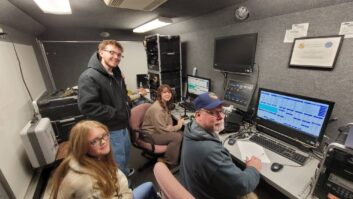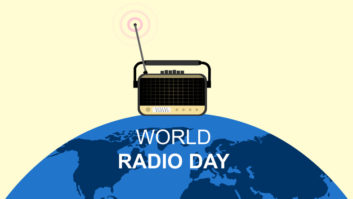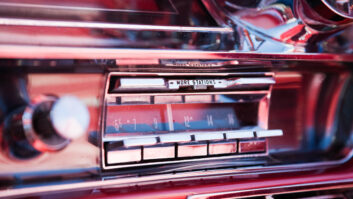
Ed Glab is shown in WLS Control Room A sometime in the mid-1990s. CHIGAGO — Ed Glab tried to learn something new every single day during his more than 40 years as broadcast engineer at WLS(AM/FM) in Chicago. That accumulation of knowledge made Glab an extremely valuable commodity and enabled him to survive lots of management changes and an ownership switch.
Retirement from the Cumulus-owned stations in late June ended what Glab, 65, called “four decades of being on call.” That sort of dedication requires a passion for broadcast engineering.
“Radio can be a very demanding mistress, but I have loved most of it. I started with consoles that had vacuum tubes in them and cart machines. I could draw the entire functional diagram of the radio station on a napkin,” said Glab.
At retirement he held the title of engineering supervisor.
‘A BIG DEAL’
In 1967, Glab was attending the prestigious Northwestern University, majoring in radio, TV and film in the School of Speech. He answered an ad for an on-air summer relief position at WYFE(AM) in Rockford, Ill. He joined the clear-channel AM directional as an on-air fill-in after passing the test for the FCC’s First Class license.
“Then halfway through the summer the CE quit,” Glab said, “so I was named chief engineer” — because he held that license.
In 1968, Glab returned to school and by happenstance met Carl Nelson, who was engineering supervisor at WLS(AM). Nelson mentioned that the station hired people for summer relief in the engineering department. Glab joined them for that summer.
However, the allure of on-air employment was still attractive to Glab, so after finishing his degree and rejoining WLS for about nine months, he left to work on-air shifts at stations across Illinois in Highland Park and Aurora, which are considered part of the Chicago metro.
Glab interviewed for the production director’s position at WLS in 1973 but instead joined the station full-time as a board operator, a position that was in the engineering department.
“I figured I would take it until something better came along. Here we are 40 years later,” Glab said with a chuckle.
Back then, board ops were the only station personnel allowed to touch equipment, Glab said; on-air folks had a mic, stopwatch and headphone jack. “[WLS] was a very strong union shop. Board ops ran all the equipment. So when the on-air people got a cough switch it was a big deal. Eventually, all that changed, of course.”
Glab at one point even had a lifetime guarantee of employment, he recalled. The International Brotherhood of Electrical Workers local in Chicago negotiated the agreement, covered the entire engineering staff, with the then ABC-owned radio stations.
“I believe it was the only such contract ever negotiated. We had 15 people in the engineering department, but ABC soon came back and renegotiated that out,” he said of the guarantee. “They also bought out a number of the engineers and reduced staff.”
By that time, Glab had moved to equipment maintenance, figuring it provided more job security than being a board op. “Engineering is more stable than any other department at a radio station. No matter the ownership changes, or program and management changes, they always need capable engineering talent who know the stations.”
Glab always looked for opportunities to contribute and make himself more useful. If there was something that needed to be done he did it, Glab said.
“If it meant learning the office phone system, even though that kind of work wasn’t covered in the engineering contract, I did because I thought it added value to my job.”
Glab learned how to write computer code in the 1980s and eventually wrote computer software for the online streaming software the WLS stations still use. Glab also wrote the program for the Radio Data System that the facilities use to transmit song title and artist information on receiver displays.
“Some of it is so complicated I’m having trouble explaining it to my replacement. Sometimes it’s a lot of work and effort to find the right solution.”
One of the highlights of Glab’s career was building new studios for the AM and FM operations of WLS in 1990, he said. Glab designed the floor plan for the studio areas and spent nine months wiring the AM talk studio. “I think being on-air at one point helped me through the process to understand what the on-air people needed to make their jobs easier. It was a very satisfying experience. We came up with something that has served us for the past 23 years and is still serviceable.”
WLS(AM) is a 50 kW non-directional clear channel station on 890 kHz. It airs a news/talk format and carries local programming in addition to Rush Limbaugh and Sean Hannity. WLS(FM) is a Class B station on 94.7 MHz featuring a classic hits format. The FM broadcasts in HD Radio; the AM aired digital for a short time in 2008. Citadel, which owned the stations at the time, made the decision to limit the AM HD to daylight hours and then to turn if off entirely because of interference concerns, Glab said.
‘MORE FLEXIBILITY’
His one regret about retirement is never having the chance to work in a state-of-the-art radio studio environment.
“Now they are doing audio over IP and I see so much more flexibility built into something like that. Today’s audio over IP systems make installation so much easier than what we had in 1990. We are still using the basic infrastructure. The consoles and the basic wiring is the same.”
If given another opportunity to build a new radio station, Glab says he wouldn’t change the WLS studio design much. “I’d make the talk studios larger. I feel our choice of the Pacific Recorders consoles was one of the best decisions we made. They were built like tanks and have proven their reliability,” Glab said. “There are some systems out there today that don’t have the physical ruggedness that Jack Williams built into his consoles. Consoles take a beating. Our AM Control Room A has been on air for 23 years with only a handful of hours down for maintenance.”
Still, the physical plant of a radio station today is vastly different than in 1973, Glab said, with computers greatly changing how a radio station is designed and how broadcast engineers do their jobs. “In a way things are more specialized but infinitely more flexible. What you can do with computers has changed the business exponentially,” he said.
Glab said he might have retired sooner had Federal Reserve Chairman Ben Bernanke not kept interest rates so low in recent years, which limited the growth of his retirement savings. He also doesn’t see a great future for terrestrial radio.
“The threat of removing AM/FM from the dashboard and from the entertainment systems in automobiles is real. Some say it could start happening within three to five years. The sheer number of entertainment options will make it more difficult to compete for listeners in the car where so much [radio] listening takes place. You have to do good local programming to be successful.”
However, he feels that radio operates in an “atmosphere of huge conglomerates,” and that as a result, “the impetus to do good local radio just isn’t there. And that is going to really hurt radio.”
Replacing Glab in the Windy City Cumulus engineering department is Tim Wright, who comes aboard from Clear Channel. The department also includes Chief Engineer Scott Clifton and IT Chief Carlos Gonzalez.
Clifton called Glab “a very unique and legendary radio engineer,” and said the retiring engineer spent most of his last week at work in mid-June preparing others on how to do his job, “including creating a binder of how-to type manuals on many software programs he has written for our operations.”
In retirement, Glab might consider a return to the organ. He used to play the instrument in a church and was paid for it.
“I haven’t done that for 35 years, but I’m considering it. I have been bitten by the theater organ bug. It’s a very whimsical instrument. I am thinking about building a virtual theater organ at home,” he said.
Glab has been married to his wife, Lenci, for 38 years. The couple resides in Elk Grove Village, Ill.







